Intro
Discover 7 ovarian cyst rupture symptoms, including severe pelvic pain, heavy bleeding, and nausea. Learn to identify signs of ovarian cyst complications, such as torsion and infection, for prompt medical attention and effective treatment.
Ovarian cysts are fluid-filled sacs that can develop on the ovaries, and while many are harmless, some can rupture, leading to severe symptoms and potentially life-threatening complications. It's essential to recognize the signs of an ovarian cyst rupture to seek medical attention promptly. Ovarian cyst rupture symptoms can vary in severity, but being aware of the common indicators can help individuals take proactive steps to protect their health. The importance of understanding these symptoms cannot be overstated, as timely medical intervention can significantly improve outcomes.
The potential health implications of an ovarian cyst rupture are far-reaching, and the condition can affect anyone with ovaries, regardless of age. However, some individuals are at a higher risk due to factors such as family history, previous ovarian cysts, and certain medical conditions. Given the severity of the symptoms and the potential for serious complications, it's crucial to educate oneself on the warning signs of an ovarian cyst rupture. By doing so, individuals can empower themselves to seek medical help when needed, potentially preventing long-term damage and ensuring the best possible health outcomes.
Recognizing the symptoms of an ovarian cyst rupture is the first step towards receiving appropriate medical care. These symptoms can range from mild to severe and may include sudden and severe pelvic pain, vaginal bleeding, nausea and vomiting, fever, and rapid heart rate, among others. Understanding the nature of these symptoms and how they may manifest can help individuals identify when something is amiss, prompting them to seek the medical attention they need. Furthermore, being informed about the diagnostic processes and treatment options available for ovarian cyst ruptures can alleviate anxiety and uncertainty, making the experience less daunting for those affected.
Ovarian Cyst Rupture Overview
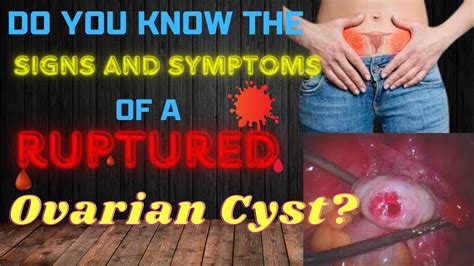
Causes of Ovarian Cyst Rupture
The causes of an ovarian cyst rupture can be diverse, including: - Large cyst size: Cysts that are larger in size are more prone to rupture. - Hormonal changes: Fluctuations in hormone levels, particularly during the menstrual cycle, can cause the cyst to rupture. - Physical activity: Engaging in strenuous physical activities may increase the risk of cyst rupture. - Trauma: Direct trauma to the pelvic area can cause an ovarian cyst to rupture. - Pregnancy: In some cases, pregnancy can increase the risk of an ovarian cyst rupture.Symptoms of Ovarian Cyst Rupture
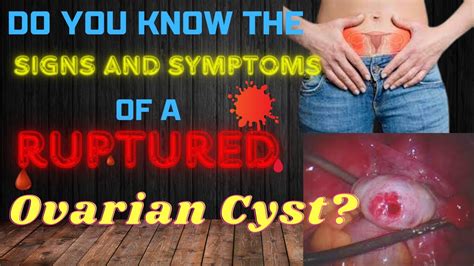
Differentiating Symptoms
It's crucial to differentiate the symptoms of an ovarian cyst rupture from other conditions that may present similar symptoms, such as appendicitis, ectopic pregnancy, or kidney stones. A thorough medical evaluation, including imaging tests and blood work, can help determine the cause of the symptoms.Diagnosis of Ovarian Cyst Rupture
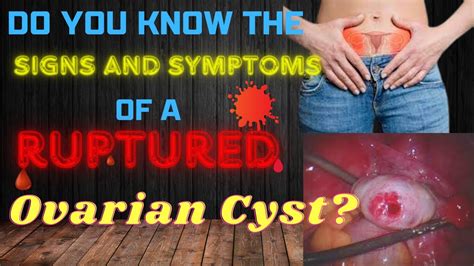
Importance of Prompt Diagnosis
Prompt diagnosis is critical in the management of an ovarian cyst rupture. Early detection can help prevent severe complications, such as infection, hemorrhage, and infertility issues. It also allows for timely intervention, which can significantly improve outcomes and reduce the risk of long-term health consequences.Treatment of Ovarian Cyst Rupture

Surgical Interventions
Surgical intervention may be necessary in cases where the rupture is severe, there's significant bleeding, or other complications are present. The type of surgery can vary from a laparoscopic procedure, which is less invasive, to an open surgery, depending on the individual's condition and the surgeon's judgment.Prevention of Ovarian Cyst Rupture

Lifestyle Modifications
Lifestyle modifications, such as avoiding strenuous activities when a cyst is present, can also play a role in preventing rupture. However, it's essential to follow the advice of a healthcare provider, as the best course of action can vary depending on the individual's specific situation.Complications of Ovarian Cyst Rupture
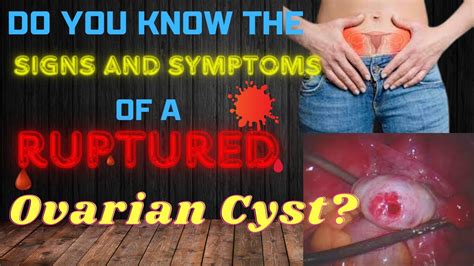
Long-term Implications
The long-term implications of an ovarian cyst rupture can be significant, affecting not only fertility but also overall quality of life. Chronic pain, infertility, and an increased risk of future ovarian cysts are potential long-term consequences, highlighting the importance of prompt and effective treatment.Recovery from Ovarian Cyst Rupture
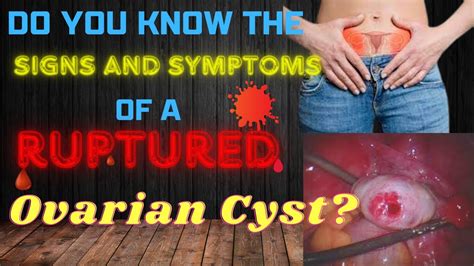
Support During Recovery
Support during the recovery period is crucial, both physically and emotionally. Family, friends, and support groups can provide valuable assistance, helping individuals cope with the aftermath of an ovarian cyst rupture and navigate the road to recovery.In conclusion, recognizing the symptoms of an ovarian cyst rupture and seeking prompt medical attention are critical for preventing severe complications and ensuring the best possible outcomes. By understanding the causes, symptoms, diagnosis, treatment, and prevention strategies related to ovarian cyst ruptures, individuals can take proactive steps to protect their health and well-being. If you or someone you know is experiencing symptoms of an ovarian cyst rupture, it's essential to act quickly and consult a healthcare provider.
What are the most common symptoms of an ovarian cyst rupture?
+The most common symptoms include sudden and severe pelvic pain, vaginal bleeding, nausea, vomiting, fever, and rapid heart rate.
How is an ovarian cyst rupture diagnosed?
+Diagnosis involves a combination of physical examination, medical history, and diagnostic tests such as ultrasound, CT scan, or MRI, and may include blood tests and laparoscopy.
What are the potential complications of an ovarian cyst rupture?
+Potential complications include hemorrhage, infection, infertility, and adhesions, which can lead to long-term health consequences.
Can ovarian cyst ruptures be prevented?
+While not all ruptures can be prevented, regular check-ups, monitoring of known cysts, maintaining a healthy lifestyle, and avoiding strenuous activities when a cyst is present can reduce the risk.
What is the recovery process like after an ovarian cyst rupture?
+Recovery involves rest, pain management, and follow-up care with a healthcare provider. Support from family, friends, and potentially support groups can also be beneficial during this period.
We hope this comprehensive guide has provided you with valuable insights into ovarian cyst ruptures, from recognizing the symptoms to understanding the treatment options and prevention strategies. If you have any further questions or concerns, please don't hesitate to reach out to a healthcare professional. Your health and well-being are paramount, and seeking knowledge is the first step towards empowerment. Share this article with someone you care about, and let's work together to raise awareness about this critical women's health issue.
